Monolith AI and Simcenter STAR-CCM+ bring machine learning to CFD simulations
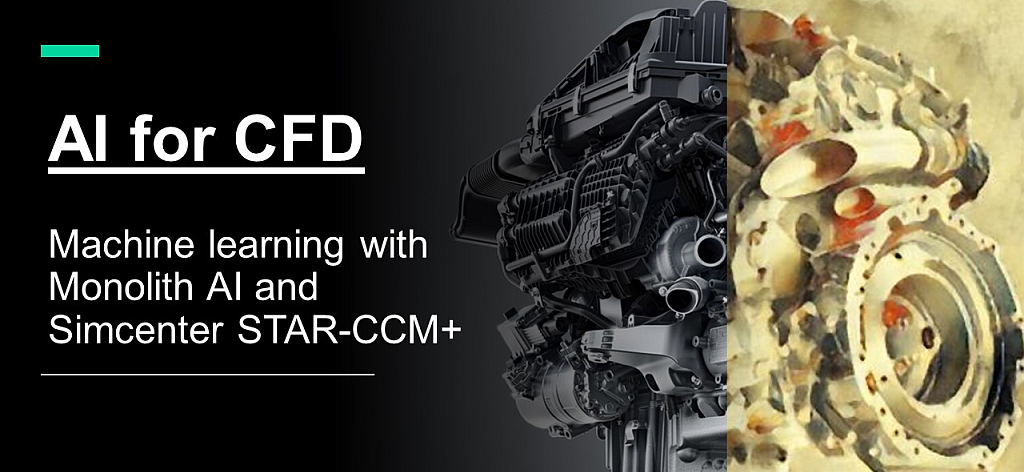
Artificial Intelligence (AI) for CFD simulations
Artificial Intelligence (AI) is not just a buzzword anymore. AI is already transforming technology in every industry. For engineers, product designers and computational fluid dynamics (CFD) simulation specialists, an important question is: how can AI benefit me as an engineer designing systems and hardware?
We know shorter time to results and better usage of existing data are two important aspirations for engineers. Alongside our efforts to accomplish this within the simulation process, we see large dividends from investment in AI technology specifically. There are many useful ways to integrate AI into a CFD space to augment productivity. In this blog, we discuss one such example in detail: using simulation data to train a machine learning (ML) model to make real-time predictions possible throughout the design space. But first, a bit about how AI has permeated into engineering simulation space from hype to proven value.
Monolith AI + Simcenter STAR-CCM+ => Design Freedom
GPUs have advanced from hundreds of parallel (CUDA) cores to thousands in the last 5 years. This is integral for quick calculation times in AI modeling. 100,000+ publications on AI topics globally cited for 2019. Countless platforms available to kick-start AI projects. A staggering 35,000+ citations for a certain popular machine learning module in Python (Scikit-learn). It is truly an exciting time for CFD engineers, as we can take advantage of these incredible advancements in AI without having graduate degrees in AI ourselves.
We are past the point of questioning if AI can be useful in our simulation communities. Instead, we are now asking (among other questions) which problems are most suitable for AI to help us with. To answer this, Monolith AI, the leading platform for design and engineering, and Simcenter STAR-CCM+ have joined forces to bring the next level of design freedom to engineers.
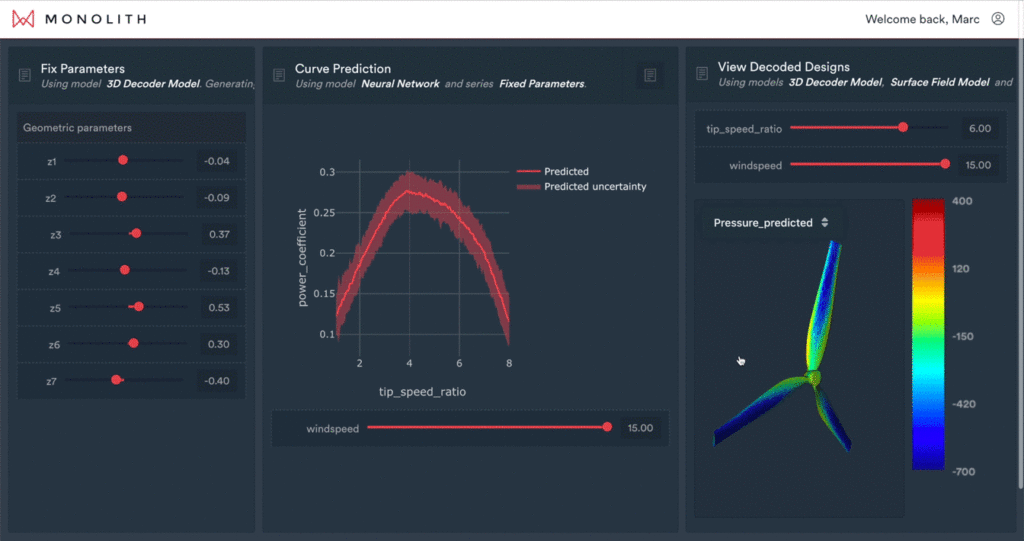
AI + CFD for an internal combustion engine (ICE) design
Let’s consider a proof of concept we recently completed with Monolith AI and Simcenter STAR-CCM+. We used AI to further what is possible in a design exploration study on an internal combustion engine simulation with Simcenter STAR-CCM+.
It is not uncommon for engineers who design internal combustion engines to be faced with a relatable problem: too many design permutations to consider in too short of a time. Whether it be physical test, and/or a variety of simulation tools, there are too many variables and different data sources to consider. To effectively sift through all possibilities and arrive at the most superior design is challenging.
Our solution is to create an AI model which can take important geometric parameter values as input from a user. The model will then provide accurate predictions of the performance associated with that design in real time.
Furthermore, we didn’t just task ourselves with predicting a single scalar for a design. We also focused on the evolution of results over time for the full piston cycle. In addition, the 2D planar and 3D distributions of results throughout the domain were also considered. All it takes is a few hours spent planning both your simulation and AI modeling space upfront, and at your fingertips, you will have the ability to more thoroughly explore your full design space in real-time!
Training the Monolith AI model
Among the geometric parameters for this study which describe the piston-cylinder bowl, there were three parameters of interest that stood out and were selected: the port bend angle, the pre-seat height, and the valve radius. These parameters will moderate the uniformity of the introduced flow and strength of the secondary structures throughout the recirculating zones.
Therefore, when divvying up the simulation data for training and validation, we wanted to do so in a way that would challenge the AI model to make general predictions by splitting up the data in a specific way. Specifically, we trained the AI model on only the sharp port angle cases (30° – 40°), while conducting validation testing on the less steep angle cases (40° – 50°). This helps challenge the AI model to make general predictions by training and validating on flow-fields with different levels of separation and recirculation.
In all circumstances, the workflow and flow of data between tools was the same:
- Run CFD simulations in Simcenter STAR-CCM+
- Extract necessary simulation data, post process, and re-arrange (tabular)
- Feed prepared data to Monolith AI for AI model development
- Make predictions!
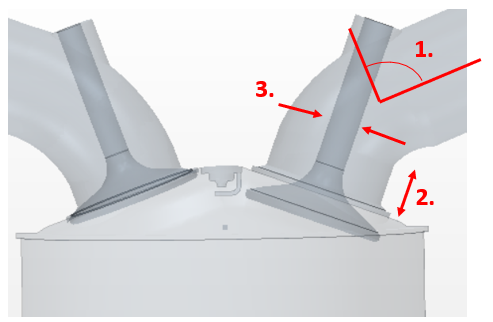
Is the AI model accurate? Very much so
After training is completed, it’s time for validation testing to see how accurate the AI model is! To accomplish this, it is as simple as restricting a portion of the data, the 40° – 50° angle port cases, from the AI model training process and then revisiting it once the model is done training. The trained model is fed the inputs from the individual validation cases and makes its own conjectures on what the output responses (results) are. Then these predictions are judged against the CFD results, which are considered a ‘ground truth’. The pressure, swirl, turbulent kinetic energy, and the y component of the swirl are predicted for every crank angle through the cycle. As pictured, the Simcenter STAR-CCM+ data (white points), the machine learning predictions (red lines), and the approximation of the AI prediction uncertainty (red band) are plotted together for the case with the most different port bend angle (50°) from the training set. The outcome – a resounding success! The results are almost indistinguishable in some areas between the simulation and AI predictions.
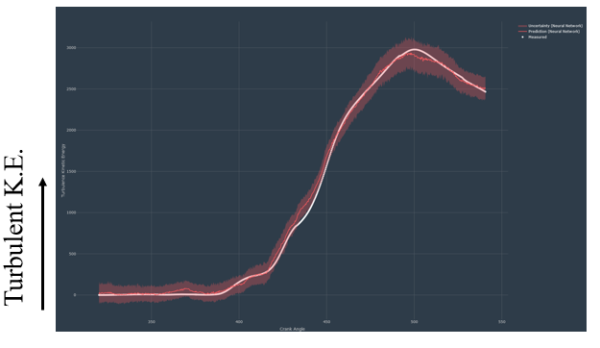
Furthermore, let’s provide a harder challenge for the AI model. Instead of predicting a time series evolution of single scalar values, let’s try to predict scalar values local on each cell through the center of the domain distinct time instances. The AI model predictions again compare very positively to the ground truth (CFD) data! For this instant in time, both the velocity magnitude field and the turbulent energy are well predicted. The high speed jetting flow, as well as the slow moving recirculating flow, are captured quite well!
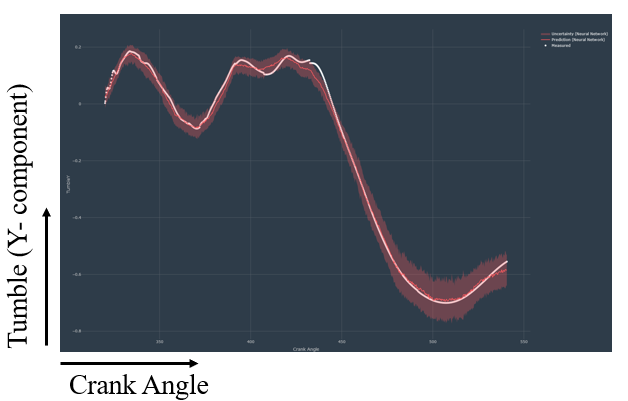
Simulation predictions in real time with AI
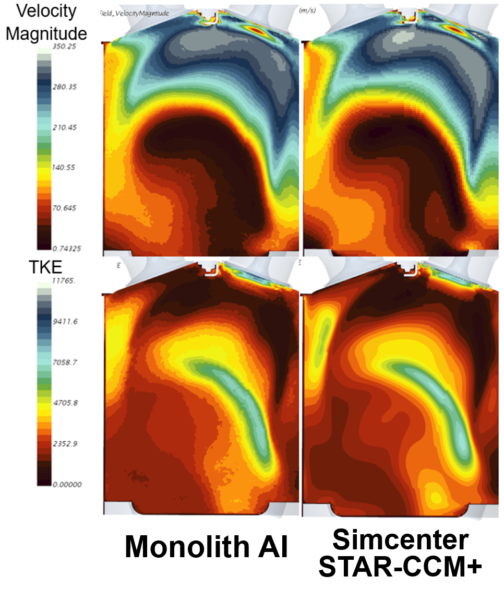
Now possibly the best part – after training is completed, predictions can be made on new cases in real-time! As someone who built up experience with CFD prior to AI, this is almost as good as magic no matter how many times I see it, despite knowing how it works! From the video recorded within the Monolith AI interface for my specific case, you can see that it only takes a few seconds from the time a new case is selected until we see the AI predicted results (right) and the CFD data for comparison (left). With authenticity and a bit of whimsy, I can imagine so many possibilities to augment design workflows and quicken design cycles with the wealth of data available (even from different sources).
A world of possibilities for your future CFD simulations
This is just one example of how AI and machine learning will change the future of CFD simulations. Our recently announced partnership with Monolith AI will help accelerate design exploration through simulation, test and AI technologies.
With an already strong foothold in data management and PLM, automation, and analytics, the addition of Monolith AI as a Simcenter partner echoes even more possibilities.
Now let’s close the blog in style – with a popular quote and a call to action. “Any sufficiently advanced technology is indistinguishable from magic”. Reach out to us today to find out how we can work together to make some magic from your existing data. Fore more information on the partnership, click the link below.




